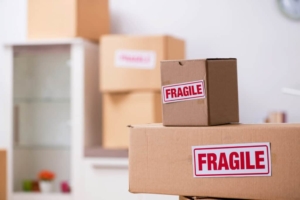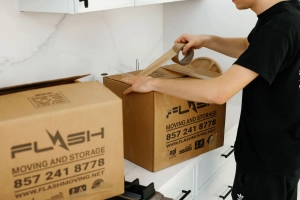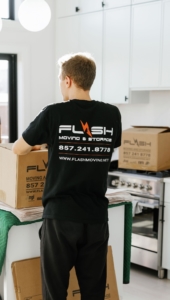Introduction to Packing Your Kitchen
Welcome to our moving blog, where we offer essential moving tips from the professionals at Flash Moving & Storage. This guide will provide detailed instructions on how to pack your kitchen effectively for a move. The kitchen is often one of the most challenging areas to pack due to its mix of fragile items, odd-shaped utensils, and various types of cookware. To get started, gather all necessary packing materials, including sturdy cartons of various sizes, packing paper, bubble wrap, small sealable bags, packing tape, and felt-tip markers for labeling. Properly organizing these supplies will help you secure your fragile items and other kitchen belongings efficiently. Incorporating more packing paper helps to cushion and stabilize items within the boxes, ensuring they do not shift during transportation, which minimizes the risk of damage. Additionally, knowing how to load your items into the moving truck is crucial to prevent damage during transport and ensure a smooth moving process. Filling any empty space within boxes with materials like packing paper or peanuts will stabilize the items and reduce the risk of damage.
Preparing to Pack
Before you start packing, it’s important to prepare your cartons. Begin by placing crumpled packing paper or packing peanuts at the bottom of each box. This cushioning layer helps absorb shocks and vibrations, providing protection for your delicate items during transit. For larger items or those that need extra protection, consider using pliable cardboard to create custom-sized packing materials. Make sure to use sufficient packing materials to avoid broken glass and other potential damage. For items that are particularly delicate, such as glassware or fine china, double boxing may provide additional security.
Packing Fragile Items

When dealing with fragile items, such as plates, follow these steps to ensure their safety:
- Wrap Plates Individually: Start by wrapping each plate in packing paper. Use several sheets of paper, beginning at one corner and wrapping diagonally, tucking in the overlapping edges. For added protection, consider using bubble wrap in addition to the packing paper. Place plates on their ends in a sturdy carton rather than laying them flat. This method helps prevent breakage and ensures better weight distribution.
- Stacking Multiple Plates: For multiple plates of the same size, place a clean sheet of packing paper between each plate. Stack them carefully and wrap the entire bundle securely. This method keeps the plates from moving and reduces the risk of chips or cracks.
- Layering and Packing: Always place the heaviest items at the bottom of the box and build up with lighter items. Divide layers with crumpled paper or packing peanuts to ensure a tight and secure pack. Fill any empty spaces with additional packing materials to prevent shifting and potential breakage. Seal the carton with packing tape and label it clearly with the room name, contents, and “fragile” with an arrow indicating the top.
Packing Bowls and Lids
 For bowls and lids, follow these steps:
For bowls and lids, follow these steps:
- Prepare Bowls: Place a layer of packing paper inside the bowl, and position the lid upside down within the bowl. Wrap both the bowl and the lid together in clean packing paper. Add an outer double layer of packing paper for additional protection.
- Packing Bowls: Pack bowls upright in the carton, similar to the method used for plates. Ensure they are snugly packed to prevent shifting and potential damage. If packing multiple bowls together, use additional packing paper to fill any gaps.
Packing Odd-Shaped Items
Packing odd-shaped items requires extra care:
- Wrap Handles: Protect any handles by wrapping them with packing paper. This shields them from potential breakage or damage. For items with protruding parts, such as large utensils, make sure these parts are securely wrapped.
- Wrap Entire Items: For additional protection, wrap the entire item in a double layer of packing paper. If necessary, use special boxes or double boxing techniques to provide extra security. For larger or particularly fragile items, consider custom-sized boxes or padded envelopes.
Packing Cups and Small Appliances with Packing paper
- Packing Cups: Wrap each cup individually in packing paper and protect the handles with an extra layer. Pack cups upside down to minimize the risk of breakage. For added security, place each wrapped cup in a small box filled with crumpled paper or packing peanuts.
- Packing Small Appliances: Wrap small appliances, such as toasters or mixers, separately. Place them in a carton with crumpled paper or packing peanuts for cushioning. Label each carton for easy identification, and if possible, use the original packaging to provide additional protection.
Packing Pots, Pans, and Cookware
 Wrap Cookware: Wrap pots, pans, and other cookware in packing paper, similar to the method used for plates. Ensure that each item is well-protected and packed securely in the carton. For large items, consider using dish packs or special boxes designed for cookware.
Wrap Cookware: Wrap pots, pans, and other cookware in packing paper, similar to the method used for plates. Ensure that each item is well-protected and packed securely in the carton. For large items, consider using dish packs or special boxes designed for cookware.- Use Cardboard Dividers: If needed, use cardboard dividers to separate larger fragile items or to fill empty spaces in the carton. This will prevent items from shifting and help maintain their condition during the move.
Handling Food Items
- Avoid Perishables: Do not pack perishable items, such as fresh produce or dairy. Only include non-perishable food items that will travel well and won’t spoil.
- Seal Food Items: For open boxes of dried or powdered foods, such as pasta, rice, and cereal, place them in sealable bags to prevent spills. Protect these bags with additional packing paper or place them in their original boxes if available.
Packing Picture Frames and Artwork with Bubble Wrap
- Protect Frames and Artwork: Use bubble wrap to protect the glass and frame of picture frames and artwork. Place the wrapped item in an interior box, ensuring it is snug and secure. For particularly valuable or large pieces, consider using custom-sized boxes or additional padding.
- Double Boxing: For large or particularly fragile items, double boxing provides added protection. Fill any extra space in the outer box with crumpled paper or packing peanuts to prevent movement.
Additional Packing Tips
- Use Pliable Cardboard: For extra protection, especially for large fragile items, use pliable cardboard to create custom-sized packing materials or additional cushioning. This can be particularly useful for odd-shaped items or delicate kitchen gadgets.
- Fill Hollow Items: If you have hollow items such as mugs or small containers, fill them with crumpled paper or packing peanuts to prevent shifting and provide extra protection. This helps to maintain their shape and prevents breakage.
- Label Clearly: Always label each box clearly with the room name, contents, and “fragile” with an arrow indicating the top. This will help movers handle each box appropriately and ensure that fragile items are treated with care. Use felt-tip markers for easy visibility and consider using color-coded labels for different rooms or types of items.
- Original Packaging: If you have the original packaging for any items, use it as it is designed to provide the best protection. For example, original boxes for small appliances or dishes are ideal for moving. If the original packaging is not available, ensure that the replacement packaging is sturdy and well-cushioned.
- Use Smaller Boxes for Heavier Items: When packing heavier items, such as pots and pans, use smaller boxes to ensure the box can be easily lifted and handled without risk of tearing or breaking. Heavier items should never be over-packed into large boxes, as this can lead to broken boxes and damaged contents.
- Wrap Delicate Items Separately: Delicate items, such as glassware and fine china, should be wrapped separately and with care. Use additional layers of packing paper or bubble wrap to ensure they are well-protected. Place these items in special boxes designed for fragile items if available.
- Organize Your Packing Process: To make unpacking easier, organize your packing process. Pack similar items together, such as all baking supplies in one box and all utensils in another. This will help you locate items quickly when you arrive at your new home.
Conclusion
Effective packing is crucial for a stress-free move. By following these comprehensive tips from the moving experts at Flash Moving, you can ensure that your kitchen items, from fragile plates to odd-shaped utensils, remain in excellent condition throughout the moving process. Utilize the appropriate packing materials, such as crumpled packing paper, bubble wrap, and packing peanuts, to safeguard your valuables. Proper packing techniques and organization will help ensure that everything arrives at your new location safely and in good condition. Remember, moving doesn’t have to be stressful with the right preparation and packing methods. Thank you for tuning into our expert advice. Remember, there’s moving, and then there’s moving with Flash.



 For bowls and lids, follow these steps:
For bowls and lids, follow these steps:




